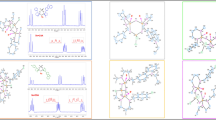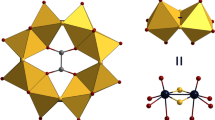Abstract
Crystal structures of novel 3-tert-butyl-8-(methylchalcogenyl)pyrazolo[5,1-c][1,2,4]triazin-4(1H)-ones, C10H14N4OE (E = S, 3; Se, 4; Te, 5), have been determined. Compound 3 crystalizes in the monoclinic crystal system (P21/c), whereas 4 provides two polymorph modifications, 4a (orthorhombic, Pbca) and 4b (tetragonal, I41/a, merohedral twin), depending on solvent media. Crystal structure of 5 (tetragonal, I41/a) is isomorphous with 4b. The studied structures of pyrazolo[5,1-c][1,2,4]triazin-4(1H)-ones exhibit a planar heterocyclic C5N4O core possessing a conjugated π-electron system, which is partly involved in the conjugation with the chalcogen atom. In general, geometric parameters found by X-ray method and ab initio calculated by density functional theory (DFT) for a single molecule (method PBE1PBE/Def2TZV, gas phase) are in good agreement. The structures form 1D infinite chains in the crystalline lattice via intermolecular NH∙∙∙O/N hydrogen bonding and demonstrate short E···E (3, 4b, 5) and E···C/N (all compounds) interactions among molecules of the neighboring chains. Such non-valence interactions do not perturb much the geometries of 3, 4b, and 5 but move the Se atom out of the C5N4O plane in 4a, compared with geometries calculated by DFT method. Photochemical studies have revealed that UV irradiation induces decomposition of telluride 5, accompanied with the Te-C8 bond cleavage, while sulfide 3 and selenide 4 remain inert under analogous conditions.










Similar content being viewed by others
Notes
It should be noted that a lesser amount of sulfur than theoretically calculated should be used in the synthesis of 3 due to high reactivity of S8 and competing formation of stable disulfides, which are hard to separate from the final product 3. We have found that below – 100 °С, the reaction of t-BuLi with elemental S is reasonably faster than that with t-BuBr. On the contrary, excess of polymeric Se or Te must be used due to incomplete dissolution at low temperatures—some unreacted Se or Te always remains at the bottom of the flask at the end of the alkylation step. Insufficient grinding of the latter two chalcogens may also lead to a significant yield reduction for 4 or 5 down to almost negligible.
The large scale work-up step, when handling selenium or tellurium (> 0.5 g of chalcogen), must be carried out in a good fume hood due to evolution of highly toxic and volatile by-products. Two pairs of good protection gloves must be worn, which have to be consequentially washed with successive amount of ethyl acetate or isopropyl alcohol, a dilute KMnO4 solution acidified with a small amount of conc. HCl, then with NaClO solution, and finally with water under the fume hood immediately each time after a contact with reaction mixtures. Oxygen mask must be provided in the case of accidental inhalation.
References
Reid DH (ed) (1970) Organic compounds of sulphur, selenium, and tellurium, vol 1. John Wright And Sons Ltd., Bristol, pp 1–494. https://doi.org/10.1039/9781847556806
Logan ME, Lang MA, Detty MR (2014) Selenium and tellurium heterocycles. Organic Selenium and Tellurium, PATAI’S Chemistry of Functional Groups. John Wiley & Sons, Ltd., Hoboken, pp 1–82. https://doi.org/10.1002/9780470682531.pat0711
Fernández-Lodeiro J, Pinatto-Botelho MF, Soares-Paulino AA, Gonçalves AC, Sousa BA, Princival C, Dos Santos AA (2014) Synthesis and biological properties of selenium- and tellurium-containing dyes. Dyes Pigments 110:28–48. https://doi.org/10.1016/j.dyepig.2014.04.044
Hamama WS, El-Bana GG, Shaaban S, Habib OMO, Zoorob HH (2016) Advances in the domain of 4-amino-3-mercapto-1,2,4-triazine-5-ones. RCS Adv 6:24010–24049. https://doi.org/10.1039/C5RA26433B
Bakhotmah DA (2020) A recent approach for the synthesis of 1,2,4-triazine systems bearing and/or containing phosphorus atoms as donor-acceptor interaction and their biocidal affects: an overview. Phosphorus Sulfur Silicon Relat Elem, in press. https://doi.org/10.1080/10426507.2020.1722668
Heri W, Beth C, Parshley T, Nabors JB (2008) In: LeBaron HM, McFarland JE, Burnside OC (eds) Chapter 3 - production, development, and registration of triazine herbicides in the triazine herbicides. Elsevier Science, Oxford, pp 31–43. https://doi.org/10.1016/B978-044451167-6.50006-4 (chapter 3) and 10.1016/B978-0-444-51167-6.X5001-6 (book)
Rusinov VL, Charushin VN, Chupakhin ON (2018) Biologically active azolo-1,2,4-triazines and azolopyrimidines. Russ Chem Bull Int Ed 67:573–599. https://doi.org/10.1007/s11172-018-2113-8
Savateev KV, Ulomsky EN, Butorin II, Charushin VN, Rusinov VL, Chupakhin ON (2018) Azoloazines as A2a receptor antagonists. Structure-activity relationship. Russ Chem Rev 87:636–669. https://doi.org/10.1070/RCR4792
Partridge MW, Stevens MFG (1966) Pyrazolo-as-triazines. part I. J Chem Soc C:1127–1131. https://doi.org/10.1039/j39660001127
Groom CR, Bruno IJ, Lightfoot MP, Ward SC (2016) The Cambridge Structural Database. Acta Cryst B72:171–179. https://doi.org/10.1107/S2052520616003954
Ivanov SM, Mironovich LM, Minyaev ME (2020) Synthesis of 8-alkylthio- and 8-selanyl-3-tert-butylpyrazolo[5,1-c][1,2,4]triazines. Phosphorus Sulfur Silicon Relat Elem, in press. https://doi.org/10.1080/10426507.2020.1712395
Ivanov SM, Lyssenko KA, Mironovich LM, Shestopalov AM (2019) Decarboxylation and electrophilic substitution in 3-tert-butyl-4-oxopyrazolo[5,1-c][1,2,4]triazines. Russ Chem Bull Int Ed 68:1714–1722. https://doi.org/10.1007/s11172-019-2615-z
Ivanov SM, Minyaev ME (2020) Generation and chemical properties of (3,4-di-tert-butyl-1,4-dihydropyrazolo[5,1-c][1,2,4]triazin-4-yl)lithiums. J Organomet Chem 906:121060. https://doi.org/10.1016/j.jorganchem.2019.121060
Ledenyova IV, Falaleev AV, Shikhaliev KS, Ryzhkova EA, Zubkov FI (2018) Unexpected reaction of ethyl 4-(chloromethyl)pyrazolo- [5,1-c][1,2,4]triazine-3-carboxylates with thiourea and its mechanism. Russ J Gen Chem 88:73–79. https://doi.org/10.1134/S1070363218010115
Voinkov EK, Drokin RA, Ulomskiy EN, Slepukhin PA, Rusinov VL, Chupakhin ON (2019) Crystal structure of medicinal product triazavirin. J Chem Crystallogr 49:213–218. https://doi.org/10.1007/s10870-018-0750-2
Ivanov SM, Mironovich LM, Kolotyrkina NG, Shestopalov AM (2019) Synthesis and chemical properties of 8-lithio-4-oxopyrazolo[5,1-c][1,2,4]triazines. Russ Chem Bull Int Ed 68:614–622. https://doi.org/10.1007/s11172-019-2464-9
Bruker (2018) APEX-III. Bruker AXS Inc., Madison
Krause L, Herbst-Irmer R, Sheldrick GM, Stalke D (2015) Comparison of silver and molybdenum microfocus X-ray sources for single-crystal structure determination. J Appl Crystallogr 48:3–10. https://doi.org/10.1107/S1600576714022985
Sheldrick GM (2015) SHELXT - Integrated space-group and crystal-structure determination. Acta Cryst A71:3–8. https://doi.org/10.1107/S2053273314026370
Sheldrick GM (2015) Crystal structure refinement with SHELXL. Acta Cryst C71:3–8. https://doi.org/10.1107/S2053229614024218
Frisch MJ, Trucks GW, Schlegel HB, Scuseria GE, Robb MA, Cheeseman JR, Scalmani G, Barone V, Petersson GA, Nakatsuji H, Li X, Caricato M, Marenich A, Bloino J, Janesko BG, Gomperts R, Mennucci B, Hratchian HP, Ortiz JV, Izmaylov AF, Sonnenberg JL, Williams-Young D, Ding F, Lipparini F, Egidi F, Goings J, Peng B, Petrone A, Henderson T, Ranasinghe D, Zakrzewski VG, Gao J, Rega N, Zheng G, Liang W, Hada M, Ehara M, Toyota K, Fukuda R, Hasegawa J, Ishida M, Nakajima T, Honda Y, Kitao O, Nakai H, Vreven T, Throssell K, Montgomery Jr JA, Peralta JE, Ogliaro F, Bearpark M, Heyd JJ, Brothers E, Kudin KN, Staroverov VN, Keith T, Kobayashi R, Normand J, Raghavachari K, Rendell A, Burant JC, Iyengar SS, Tomasi J, Cossi M, Millam JM, Klene M, Adamo C, Cammi R, Ochterski JW, Martin RL, Morokuma K, Farkas O, Foresman JB, Fox DJ (2016) Gaussian 09, Revision D.01. Gaussian, Inc., Wallingford
Becke AD (1993) A new mixing of Hartree–Fock and local density-functional theories. J Chem Phys 98:5648–5652. https://doi.org/10.1063/1.464304
Lee C, Yang W, Parr RG (1988) Development of the Colle-Salvetti correlation-energy formula into a functional of the electron density. Phys Rev B 37:785–789. https://doi.org/10.1103/PhysRevB.37.785
Stephens PJ, Devlin FJ, Chabalowski CF, Frisch MJ (1994) Ab initio calculation of vibrational absorption and circular dichroism spectra using density functional force fields. J Phys Chem 98:11623–11627. https://doi.org/10.1021/j100096a001
Chai J-D, Head-Gordon M (2008) Long-range corrected hybrid density functionals with damped atom-atom dispersion corrections. Phys Chem Chem Phys 10:6615–6620. https://doi.org/10.1039/b810189b
Adamo C, Barone V (1999) Toward reliable density functional methods without adjustable parameters: the PBE0Model. J Chem Phys 110:6158–6170. https://doi.org/10.1063/1.478522
Weigend F (2006) Accurate Coulomb-fitting basis sets for H to Rn. Phys Chem Chem Phys 8:1057–1065. https://doi.org/10.1039/B515623H
Grimme S, Ehrlich S, Goerigk L (2011) Effect of the damping function in dispersion corrected density functional theory. J Comput Chem 32:1456–1465. https://doi.org/10.1002/jcc.21759
Elschenbroich C (2006) Organometallics: a concise introduction. 3rd edn. Wiley-VCH, Weinheim 817 pages
Acknowledgments
Crystal structure determination was performed in the Department of Structural Studies of Zelinsky Institute of Organic Chemistry, Moscow.
Author information
Authors and Affiliations
Corresponding author
Ethics declarations
Conflict of interest
The authors declare that they have no conflicts of interest.
Additional information
Publisher’s note
Springer Nature remains neutral with regard to jurisdictional claims in published maps and institutional affiliations.
Springer Nature remains neutral with regard to jurisdictional claims in published maps and institutional affiliations.
Rights and permissions
About this article
Cite this article
Ivanov, S.M., Traven, V.F. & Minyaev, M.E. Structural studies of 3-tert-butyl-8-(methylchalcogenyl)pyrazolo[5,1-c][1,2,4]triazin-4(1H)-ones. Struct Chem 31, 1457–1470 (2020). https://doi.org/10.1007/s11224-020-01533-9
Received:
Accepted:
Published:
Issue Date:
DOI: https://doi.org/10.1007/s11224-020-01533-9




